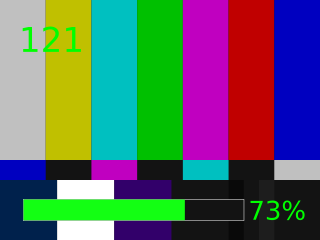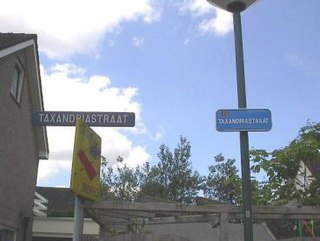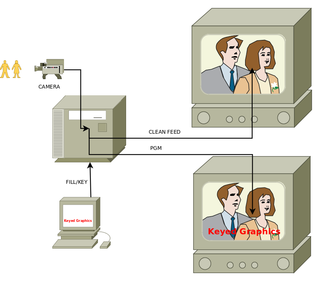
Closing credits or end credits are a list of the cast and crew of a particular motion picture, television show, or video game. While opening credits appear at the beginning of a work, closing credits appear close to, or at the very end of a work. A full set of credits can include the cast and crew, but also production sponsors, distribution companies, works of music licensed or written for the work, various legal disclaimers, such as copyright and more.
Station identification is the practice of radio and television stations and networks identifying themselves on-air, typically by means of a call sign or brand name. This may be to satisfy requirements of licensing authorities, a form of branding, or a combination of both. As such, it is closely related to production logos, used in television and cinema alike.
A digital watermark is a kind of marker covertly embedded in a noise-tolerant signal such as audio, video or image data. It is typically used to identify ownership of the copyright of such signal. "Watermarking" is the process of hiding digital information in a carrier signal; the hidden information should, but does not need to, contain a relation to the carrier signal. Digital watermarks may be used to verify the authenticity or integrity of the carrier signal or to show the identity of its owners. It is prominently used for tracing copyright infringements and for banknote authentication.

An on-screen display (OSD) is an image superimposed on a screen picture, commonly used by modern television sets, VCRs, and DVD players to display information such as volume, channel, and time.

A character generator, often abbreviated as CG, is a device or software that produces static or animated text for keying into a video stream. Modern character generators are computer-based, and they can generate graphics as well as text.

In the television industry, a lower third is a graphic overlay placed in the title-safe lower area of the screen, though not necessarily the entire lower third of it, as the name suggests.

Safe area is a term used in television production to describe the areas of the television picture that can be seen on television screens.
In computing, hardware overlay, a type of video overlay, provides a method of rendering an image to a display screen with a dedicated memory buffer inside computer video hardware. The technique aims to improve the display of a fast-moving video image — such as a computer game, a DVD, or the signal from a TV card. Most video cards manufactured since about 1998 and most media players support hardware overlay.

The National Broadcasting Company (NBC) has used several corporate logos over the course of its history. The first logo was used in 1926 when the radio network began operations. Its most famous logo, the peacock, was first used in 1956 to highlight the network's color programming. While it has been in use in one form or another for all but four years since then, the peacock did not become part of NBC's main logo until 1979 and did not become the network's sole logo until 1987. The logos were designed by NBC itself. The first logo incorporated design from then-parent company RCA, and was a unique logo not related to the NBC radio network.
This glossary of terms used in broadcasting is a list of definitions of terms and concepts related to both radio and television broadcasting, along with the industry in general.
A broadcast designer is a person involved with creating graphic designs and electronic media incorporated in television productions that are used by character generator (CG) operators. A broadcast designer may have a degree in digital media, or is self-taught in the software needed to create such content. CG stands for computer graphics, most broadcast designers studied either graphic design or visual communication – this term is used for those designing motion graphics also for film, industrials, commercials, and the web.

A nameplate identifies and displays a person or product's name. Nameplates are usually shaped as rectangles but are also seen in other shapes, sometimes taking on the shape of someone's written name. Nameplates primarily serve an informative function or a commercial role. Whereas name tags tend to be worn on uniforms or clothing, nameplates tend to be mounted onto an object or physical space. Nameplates are also distinct from name plaques. Plaques have larger dimensions and aim to communicate more information than a name and title.
In broadcasting, channel playout is the generation of the source signal of a radio or television channel produced by a broadcaster, coupled with the transmission of this signal for primary distribution or direct-to-audience distribution via any network. Such radio or television distribution networks include terrestrial broadcasting, cable networks, satellites, IPTV, OTT Video, point-to-point transport over managed networks or the public Internet, etc.

KWQC-TV is a television station licensed to Davenport, Iowa, United States, serving the Quad Cities area as an affiliate of NBC. Owned by Gray Television, the station maintains studios on Brady Street in downtown Davenport, and its transmitter is located near Orion, Illinois.
In broadcasting, local insertion is the act or capability of a broadcast television station, radio station or cable system to insert or replace part of a network feed with content unique to the local station or system. Most often this is a station identification, but is also commonly used for television or radio advertisements, or a weather or traffic report. A digital on-screen graphic, commonly a translucent watermark, may also be keyed (superimposed) with a television station ID over the network feed using a character generator using genlock. In cases where individual broadcast stations carry programs separate from those shown on the main network, this is known as regional variation or an opt-out.

In television technology, a clean feed is a video signal that does not have added graphics and text. This video signal is used in sport production to allow different television stations to add their own digital on-screen graphic image on a common signal, or in news broadcasting to produce two or more different streams, each one with the same picture but in different languages.
The analog hole is a perceived fundamental and inevitable vulnerability in copy protection schemes for noninteractive works in digital formats which can be exploited to duplicate copy-protected works using analog means. Once digital information is converted to a human-perceptible (analog) form, it is a relatively simple matter to digitally recapture that analog reproduction in an unrestricted form, thereby fundamentally circumventing any and all restrictions placed on copyrighted digitally distributed work. Media publishers who use digital rights management (DRM), to restrict how a work can be used, perceive the necessity to make it visible or audible as a "hole" in the control that DRM otherwise affords them.

Cinavia, originally called Verance Copy Management System for Audiovisual Content (VCMS/AV), is an analog watermarking and steganography system under development by Verance since 1999, and released in 2010. In conjunction with the existing Advanced Access Content System (AACS) digital rights management (DRM) inclusion of Cinavia watermarking detection support became mandatory for all consumer Blu-ray Disc players from 2012.

Jack City was a Filipino cable and satellite television network based in Shaw Boulevard, Mandaluyong. Formerly known as Chase, it serves as the spin-off channel to Jack TV. Owned by Solar Entertainment Corporation, the channel is currently broadcast on Cignal Digital TV channel 22, Destiny Cable channel 64 (analog) & channel 138 (digital), Cablelink channel 40, and SkyCable channel 138 (digital) and other cable operators in the Philippines, and is also available on live streaming via video-on-demand service Blink. It was also previously aired on BEAM TV from 2012 to 2014.
Digital on-screen graphic by country refers to how use of these logos vary in different countries and regions.











